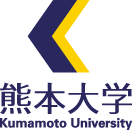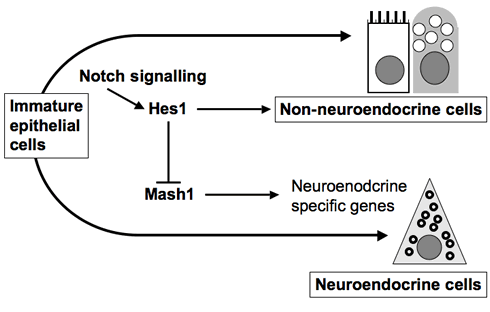- ホーム
- 講座
- 先端生命医療科学部門
- 機能病理学
機能病理学 Department of Pathology and Experimental Medicine
- 部門
- 先端生命医療科学部門
- 分野
- がん医学
スタッフ
| 助教 | 佐藤 陽之輔 |
|---|
研究テーマ
【研究プロジェクト名および概要】
病理学は、病気の原因と疾患形成メカニズム(病因論)、病気の形態学的な特徴とその臨床的な意義(病理診断)について研究・教育するとともに医療にも参加する分野です。
私たちの病理学研究室では、肺を中心とした上皮細胞やがん細胞の転写因子やシグナル伝達機構を介した細胞分化制御機構、分化と増殖機構の相互作用、形態形成機構やその異常と組織リモデリング機構、上皮組織・間質組織・癌組織などにおける幹細胞の同定と疾患形成における意義などについて明らかにしようとしています。そのために、遺伝子改変マウスを含む実験動物、マウス胎仔組織器官培養、ヒト手術組織やヒト腫瘍培養細胞などを用いて、蛍光顕微鏡や電子顕微鏡を用いた形態学的な観察、flowcytometerによる細胞解析、遺伝子発現・抑制実験による機能解析、RNA-Seq解析、CHIP-Seq解析などを行い多角的に研究し始めています。また、実際の患者よりの病理組織検体を用いての分子生物学的な手法を用いた診断法の開発なども教室の使命と考えています。
Cell fate determination of fetal airway epithelium regulated by the basic helix-loop-helix network. Neuroendocrine phenotypes depend on Mash1. In non-neuroendocrine cells, Hes1, which is activated by Notch signaling, represses mash1 expression and activation, and maintains the cells to be nonneuroendocrine.
Pathology is a science to study disease processes from the points of cause of the disease (etiology), mechanisms of its development (pathogenesis), its morphological changes and the clinical significances of the morphological changes. Thus, pathology is a bridging discipline involving both basic and clinical medical sciences.
Our research themes include 1) molecular mechanisms of cell differentiation of epithelial cells (especially lung cells) and cancer cells with focusing on transcriptional regulation and cell signal transduction pathways, 2) molecular mechanisms of modulation of cell differentiation by regulatory molecules for cell proliferation and vice versa, 3) mechanisms of epithelial morphogenesis and pathological tissue regeneration (tissue remodeling) after tissue injury, 4) identification, characterization and pathological significance of epithelial, mesenchymal, and cancer stem cells. For accomplishment of these studies, we have analyzed experimental animals including gene-targeted mice, fetal mouse tissues, cultured tissue and cells including human cancer cells, human tissue obtained at surgery by virtues of various morphological methods including electron microscopy and fluorescent immunohistochmemistry, flowcytometry, functional analyses by gene transfection and/or gene expression inhibition studies, RNA-Seq and CHIP-Seq analyses. Besides studies of basic medical sciences, we are trying to develop easy and reliable diagnostic techniques with combination of classical pathological methods and molecular techniques.


